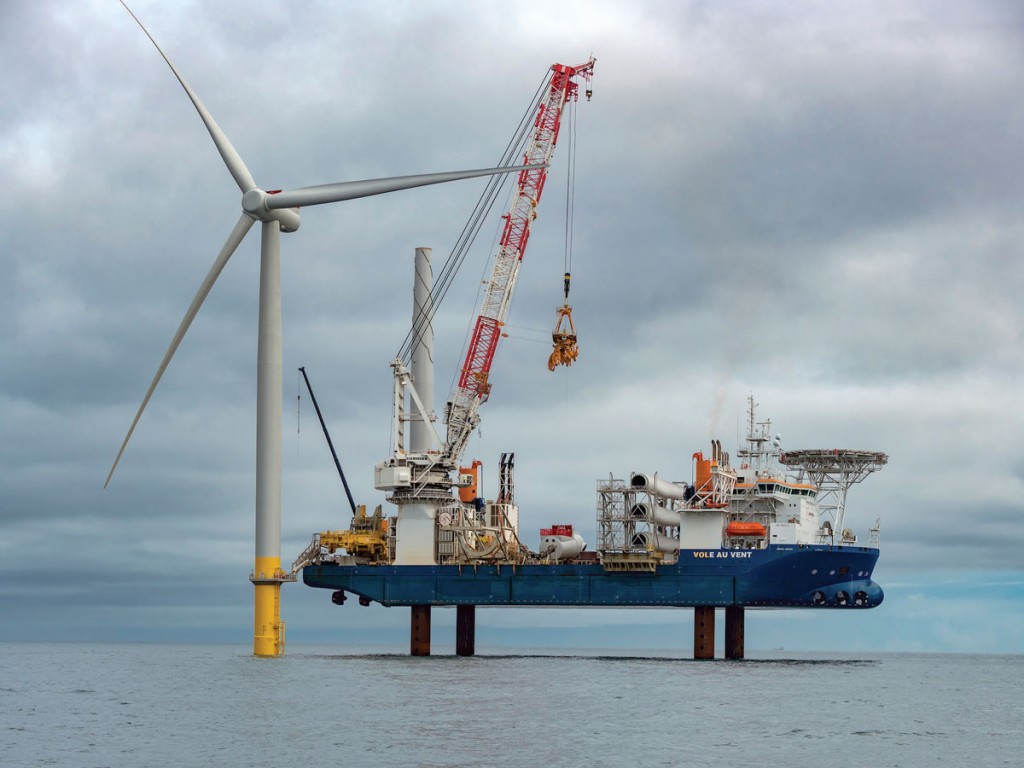Just over a century ago, the U.S. Congress passed the Merchant Marine Act of 1920, better known as the “Jones Act”, to protect the nation’s maritime interests. On the verge of potentially the greatest maritime industry boom since World War 2, the question of how to balance the dictates of the Jones Act and the commercial demands of Offshore Wind Power is a multi-trillion dollar question.

America’s offshore wind industry is set for liftoff after years of frustration, false starts and delays. This month, the country’s first large-scale commercial project, Vineyard Wind 1, announced it had secured the necessary $2.3 billion funding and will soon begin constructing its 800MW wind farm off the coast of Massachusetts, with production expected in two years’ time. Other projects up and down the eastern seaboard should follow in short order.
However, a 101-year-old law adds an element of uncertainty to this 21st Century windfall. The Jones Act, officially the Merchant Marine Act of 1920, requires American-built, operated and owned ships be deployed to transport people, goods and materials between one US port and another, between domestic destinations, or between a domestic port and point in US territorial waters. Most offshore wind projects will be situated in federal waters. Much as the oil and gas industry before it, offshore wind developers must figure out whether or not to employ Jones Act vessels to construct the wind farms or maneuver around them.
A “Tough Decision” to Make
“The USA has a tough decision to make in the next few years,” said Martin Dronfield, special advisor to James Fisher Marine Services, chairman of the East of England Energy Group and a veteran in offshore wind and oil and gas development.
Many types of vessels will be subject to Jones Act compliance over the course of offshore wind energy development and production. These “coastwise vessels” will include everything from cable-laying vessels to those that ferry crews and supplies. However, the ships that are garnering particular scrutiny are those most critical to the construction process — and the most costly: Purpose-built wind turbine installation vessels, known as wind turbine installation vessels, or WTIVs. These are ships capable of carrying and lifting the enormous wind generating components. Westwood Global Energy Group defines these as “self-propelled jackups, with crane capacity greater than 600 metric tons.”
The first Jones Act-compliant, purpose-built vessel is now under construction in Brownsville, Texas at the Keppel AmFELS shipyard. The Charybdis will cost owner Dominion Energy an estimated $500 million and is expected to launch in late 2023. It will be 472 feet long and have a lift capacity of 2,200 tons.
While a variety of state and federal agencies weigh in on matters related to territorial waters, the US Customs and Border Protection (CBP) takes the lead on arbitrating the Jones Act. The CBP has a body of decisions related to the act and oil and gas exploration that go back to the 1970s and these will be used to guide wind development, according to Michael Wray, a Houston-based partner with Holman Fenwick Willan USA LLP, and a specialist in maritime energy law. “Depending on the activity, what job you’re doing, what points you’re starting or ending, you could potentially require a coastwise vessel or you may not,” Wray explained.
In July, the CBP ruled for the first time that workarounds are legal for offshore wind projects. It decided that non-compliant vessels, which remain stationary in US territorial waters, don’t violate the law. As Claire Richer, federal affairs director at American Clean Power Association, put it: “There’s longstanding interpretation that the Jones Act applies to transportation activities, but not construction activities.”
However, the choice of what vessels to deploy is both technically and economically complicated. A compliant purpose-built installation vessel has the distinct advantage of being able to move easily from shore to site, carrying the turbines, blades and other components in carefully engineered compartments. Powerful onboard cranes can then lift these components from the ship and install them in the manner they were designed to do. The “vessels have gotten more and more specialized to create greater efficiencies,” said Richer.

The alternative: A non-Jones Act installation vessel must stay offshore. Components are ferried, usually by barges, to the site from the staging docks. This feeder-vessel strategy not only adds an extra step, but is far less efficient and more costly operationally. It requires additional vessels and fails to make full use of the installation vessels’ unique capabilities. Developers pay millions of dollars to charter underutilized assets that must stay longer on site.
Cost, though, is a two-way channel. An American-made purpose built vessel runs about 30% to 50% more than a similar vessel constructed in Asia.
All this is further muddied by what is widely expected to be a global shortage of these specialized vessels by the second half of this decade. “There is a massive increase in demand and there’s a massive demand for the vessels that are currently being built,” said Alexander Fløtre, vice-president offshore wind at the research and consultancy group Rystad Energy. “US developers opting for a feeder strategy might not be able to lure these vessels over the Atlantic and into the US region. You’d have to pay quite high rates to get that to happen.”
Future Global Demand
Westwood, for one, projects the imbalance could reach nine vessels outside of China by 2028. That may not sound like much, but that’s some 30% of the current non-China fleet. The Jones Act could actually propel the need for additional new vessels, according to Westwood’s Thom Payne, who heads the group’s offshore analysis.
In late-May, Westwood put the number of installation vessels worldwide at 46, of which 70% were operative. The vast majority of these, 21, were working offshore mainland China, as this year alone the country is adding an astounding 10GW of offshore wind. In China, there’s a “veritable flotilla of vessels of all shapes and sizes that have been mobilized into the region from all over the world,” said Payne.
Most of these vessels will remain tethered to the China market.

Westwood in a position paper in August, said the number of installation vessels serving the international market totaled 18. It said there were eight firm orders for newbuilds destined for the international market outside China, three confirmed upgrades, plus four potential orders “at various stages of discussion.”
The need for installation vessels is part of a wider spike for vessels necessary for offshore wind development. This includes cable-laying vessels, heavy-lift vessels used for foundation work, service vessels, and maintenance vessels. “Depending on your kind of vessel logistics, you can get anywhere from 18 to more different types of vessels,” said Richer.
“The entire logistical chain needs to be upgraded,” added Matthieu Moerman, head of marine projects at SAL Heavy Lift, part of an alliance with Jumbo Shipping.
The US isn’t producing offshore wind in a vacuum and many countries will be ramping up development during the latter part of this decade. “The activity in the US will peak at the same time as we expect European activity to really take off, as well as Taiwan as well as Vietnam as well as Japan and South Korea,” said Fløtre. “We see bottlenecks not just for the US, but globally.”
The International Energy Agency (IEA) is now projecting that by 2030, offshore wind will be adding 80GW per year. Westwood estimates 12,000 turbines will be installed by 2028.
What’s more, turbines are getting larger and heavier and corresponding blades are getting longer, which means installation vessels must be capable of far heavier lifts than older generation ships. “The cutting edge vessels of five or seven years ago are now relegated to maintenance campaigns,” said Payne. “The same thing is going to happen to the current generation. That’s the way the market’s moving.”
Current generational turbines are in the eight to ten megawatt range, but not for long. The Vineyard Wind project, for example, will utilize GE’s latest generation Haliade-X turbine. These turbines start at 12MW, which translates into a 600-tons nacelle. Each blade weighs 55 tons and stretches 107 meters.
This further constricts the available fleet size. Westwood projects only one of the existing 18 vessels now serving the international market can install these next-generation turbines of 12MW plus.
None can handle the 14MW turbine Siemens Gamesa unveiled last year. To jumpstart the process, Siemens Gamesa awarded a $90 million contract in March to Cadeler A/S for transportation and installation of these mammoth turbines when they go into production beginning 2024. In June, Copenhagen-based Cadeler announced it had signed a $650 million contract with China’s COSCO for two newbuilds capable of installing the turbines. The first vessel is scheduled to be finished by the third quarter of 2024.
Analysts expect turbines will reach 20MW by the end of this decade.
Investing in the US Market
Dominion Energy decided it was worth investing in its own installation vessel after a two-turbine pilot project, said company spokesman Jeremy Slayton. Dominion is spearheading the 2.6GW Coastal Virginia Offshore Wind project off Virginia Beach, which is expected to be completed in 2026. According to Slayton, for the pilot project, developer Ørsted relied on a European installation vessel that staged its supplies in Halifax, Canada, to get around Jones Act regulations. The extra transportation time, more complicated logistics and risks involved convinced the utility that “there is a need for a Jones Act compliant vessel,” Slayton said, not only for the Virginia project, but for other offshore wind farms on the East Coast.
It’s unusual for a developer to take on owning a vessel, said Fløtre. But there are solid reasons for the decision. One of America’s largest utilities, Dominion Energy has the cash flow to underwrite such an investment. Owning a vessel insures the equipment will be available when needed for its own project. And, suggested Fløtre, Dominion’s first mover advantage could help insure business from others.
Demand for such a vessel is easily evident. Dominion announced in June that it would charter the Charybdis to the Ørsted-Eversource consortium, which is developing both the Revolution Wind and Sunrise Wind projects off the shores of New York, Connecticut and Rhode Island.
The Vineyard Wind project, on the other hand, will be chartering a European installation vessel and relying on feeder barges. It really has no choice.
Add to all this competition from oil and gas exploration, which is heating up again after two years of reduced activity. “There is a fight between LNG projects and renewable projects,” said Moerman. “There you clearly see a shortage in market.”
Like other jack-up vessel manufacturers, the SAL-Jumbo alliance is working on new designs to accommodate the larger and heavier wind turbines, according to Moerman, while actively exploring opportunities in the US market.
However, finding those willing to bankroll the investment is easier said than done. “There is a huge risk as a contractor,” said Payne. “They’ll be saying, ‘the US is a great market, but if I spent the extra hundred million to build it there, am I going to get anything out of the back end?’”
The Dutch heavy equipment manufacturing giant Huisman, for one, is hedging its bets. Last year, it secured the crane contract for the Charybdis. A few months back, Huisman announced a piece of equipment it says will make it easier for feeder vessels to operate in tandem with stationary jack-up installation vessels. This “motion compensated platform” provides necessary stability for the transfer of components at sea, especially during rough weather.
NETSCo is also looking at alternatives. Late last year, the naval architectural and engineering firm announced alongside Lloyds Register an agreement to jointly design and develop a Jones Act compliant wind turbine installation vessel. In June, NETSCo said it would also provide engineering services to convert vessels for use in offshore wind.
Some have suggested that oilfield services vessels, now in operation in the Gulf of Mexico, could be converted for use in offshore wind. It’s certainly feasible and these operators have the experience necessary for the work. However, others caution that these current vessels may be too old to warrant the necessary modifications for offshore wind. Add to this the greater wear-and-tear of offshore wind farm installation compared to oil and gas because a vessel must be jacked up far more times.
Will there be a flurry of Jones Act-compliant installation vessels? Legislators are certainly pushing for this to happen. Congress added language to the fiscal 2021 National Defense Authorization Act that specifically said the Jones Act should be applied to “installations and other devices permanently or temporarily attached to the seabed” for use in the development and production of “non-mineral energy resources.”
Some compare the decision-making process to offshore oil and gas exploration in the Gulf, which has largely relied on feeder-type workarounds. However, Payne added, offshore wind is far more political than the mature oil and gas industry. “There is a big incentive and a focus on country value, and that’s what’s the Jones Act is all about,” he said. “So, I would expect a strong preference to be given to transact compliant vessels.”
James Fisher’s Dronfield believes a reliance on Jones Act ships will serve as an additional benefit to the industry. “Staunch implementation of the Jones Act will make the next few years tough, but they will ensure a relatively speedy localization of the industry,” he said.




